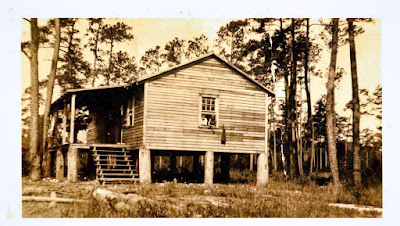Anyone who's ever lived in Kingstree, South Carolina, has no doubt spent time on the banks of Black River at what is still known to many as The Scout Cabin but is officially Gilland Memorial Park. Standing in the park today it is difficult to imagine that in the early part of the 20th century it was called Gilland Spring and was difficult to access.
A park bench on the banks of Black River at Gilland Memorial Park.
Occasionally, groups did go to the spring for events. In 1901, The County Record reported that a wagonload of members of the Kingstree Club had traveled the distance to Gilland Spring to hold a barbecue and fish fry, complete with an ice cold keg of beer. Two years later, the older students of the Kingstree Academy celebrated a Washington's Birthday holiday with a picnic at Gilland Spring.
The spring was originally part of the Thomas Day Singleton plantation which encompassed the northern portion of Academy Street from Williamsburg Presbyterian Church to the house at the head of the street and stretched from what is now the old Kingstree Elementary School to the river. Singleton's granddaughter, Louise Brockinton Gilland, known to all as "Miss Lou," inherited the plantation and by the 1920s she had allowed the Kingstree Boy Scouts to build a little cabin at the springs. In 1927, she agreed that the Scouts, then sponsored by the Kiwanis Club, could build a more substantial cabin there.
A later, undated photo of the Scout Cabin.
Both photos courtesy Williamsburgh Historical Museum
The cabin was used for meetings as well as camping trips. The Florence Morning News of May 14, 1932, noted, "A number of high school girls went on a hike to the Scout Cabin Saturday morning for a breakfast picnic. A crowd of Scouts who had camped at the cabin Friday night participated in the picnic.
Miss Lou's son, Louis Gilland, an attorney and former mayor of Kingstree died, in 1929. In May 1933, she donated five acres, including the area then known as The Scout Cabin, for use as a park. A committee of the Kiwanis Club, which sponsored the park, named it "Louis Gilland Memorial Park."
A marker commemorating the land donation stands in Gilland Park.
Funding for the park was made possible through the New Deal's Reconstruction Finance Corporation (RFC). A story published June 29, 1933, in the Florence Morning News, noted, "The site of the park is a beautiful one at the conjunction of Broad Swamp and Black River where a high bluff has made the spot a famous seineyard from the early history of the county."
The story goes on to explain that up until 1933, the area of the park had been difficult to access except on foot, noting that there was no bridge over the swamp. Using RFC funds, a 30-foot road was constructed "through the virgin forest of the swamp," and a bridge built. F.J. Watson donated the lumber for the bridge, with J.C. Epps cutting the logs at his sawmill.
A fisherman tries his luck in the serene waters of Black River.
Workmen cleared stumps and roots from the park grounds and also cleared the riverbed to make swimming easier. The surrounding swamp was cleared of underbrush and rubbish. The Morning News stated that "two good spring boards with ladders and a big flat have been erected as well as a 50-foot flagpole." Future plans included boring an artesian well, a community house with bath house attached, and an outdoor oven and barbecue pit. They also hoped to hire a permanent superintendent for the park.
T.W. Gilland, I.V. Campbell, F.J. Watson, and Dr. J.W. Davis were appointed trustees of the park for life, with the Mayor of Kingstree serving for the duration of his term.
Dogs, as well as people, enjoy cooling off in the river on a hot summer day.
In 1958, the Kingstree Rotary Club improved the beach and swimming facilities. James Hinnant, a Rotarian and town council member, supervised the project. A July 5, 1958, Florence Morning News article said, "Tons of earth and rock were hauled to the Black River to build a large groin or dam, stretching high and far into the river. This groin serves to protect the park property from erosion and directs the channel of the river back to its original position after high water."
These improvement also included a wide, white sand beach on the park side of the river and the inclusion of a sandbar near the center for a sunbathing area. The article noted, "Only those who frequented the Black River in the old days can fully appreciate these improvements. Last summer, and for summers before, the beach was on the far side of the river. To get to the sand, the bather had to climb down a steep bank of black dirt and swim or wade through the water."
No matter what season, Gilland Park is a beautiful part of Kingstree.
The current gazebo, playground and picnic facilities were brought to the park in 1988. In 1933, a large sign hung at the entrance to the park, noting Louis Gilland Memorial Park, 1933. The reverse side of the sign stated simply: This park is for your pleasure. Please do not abuse.







1 comment:
Great explanation.
Post a Comment